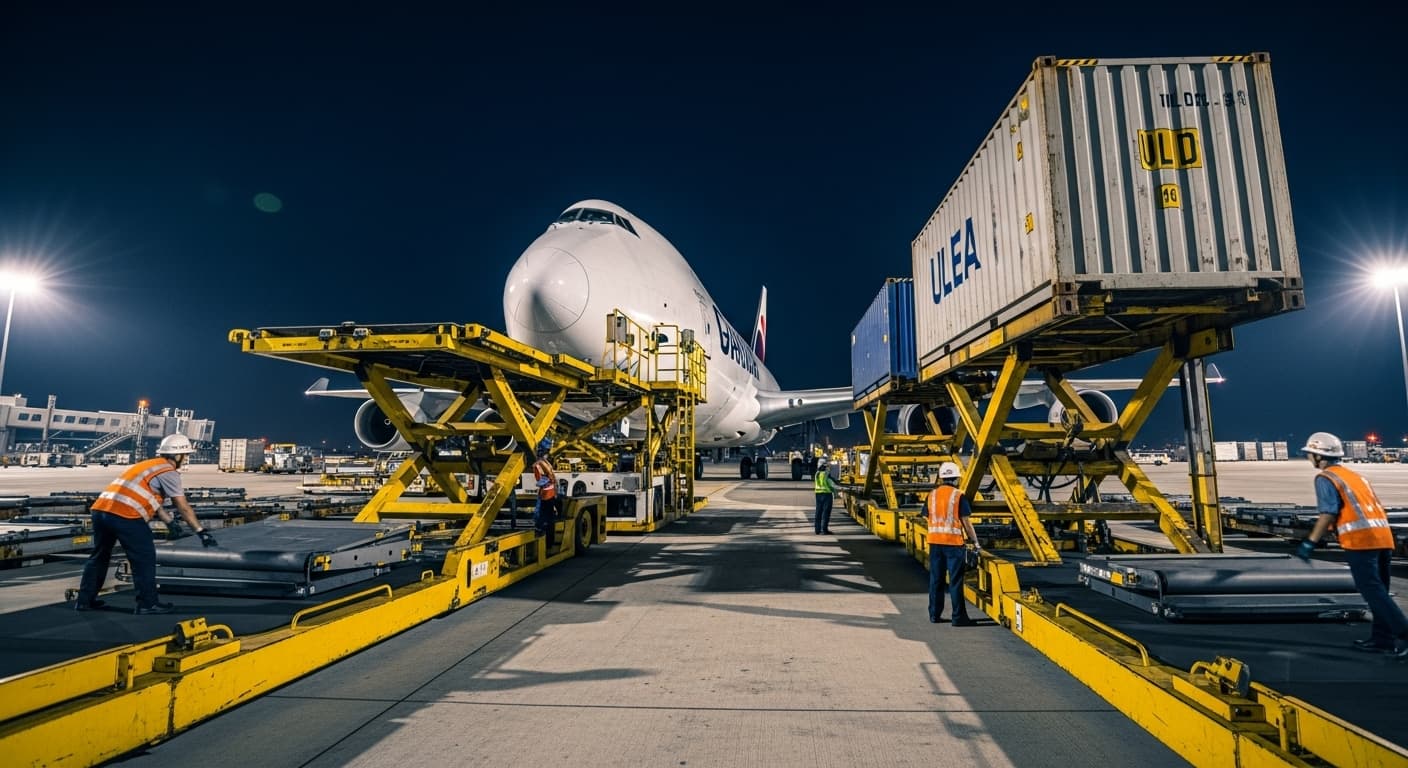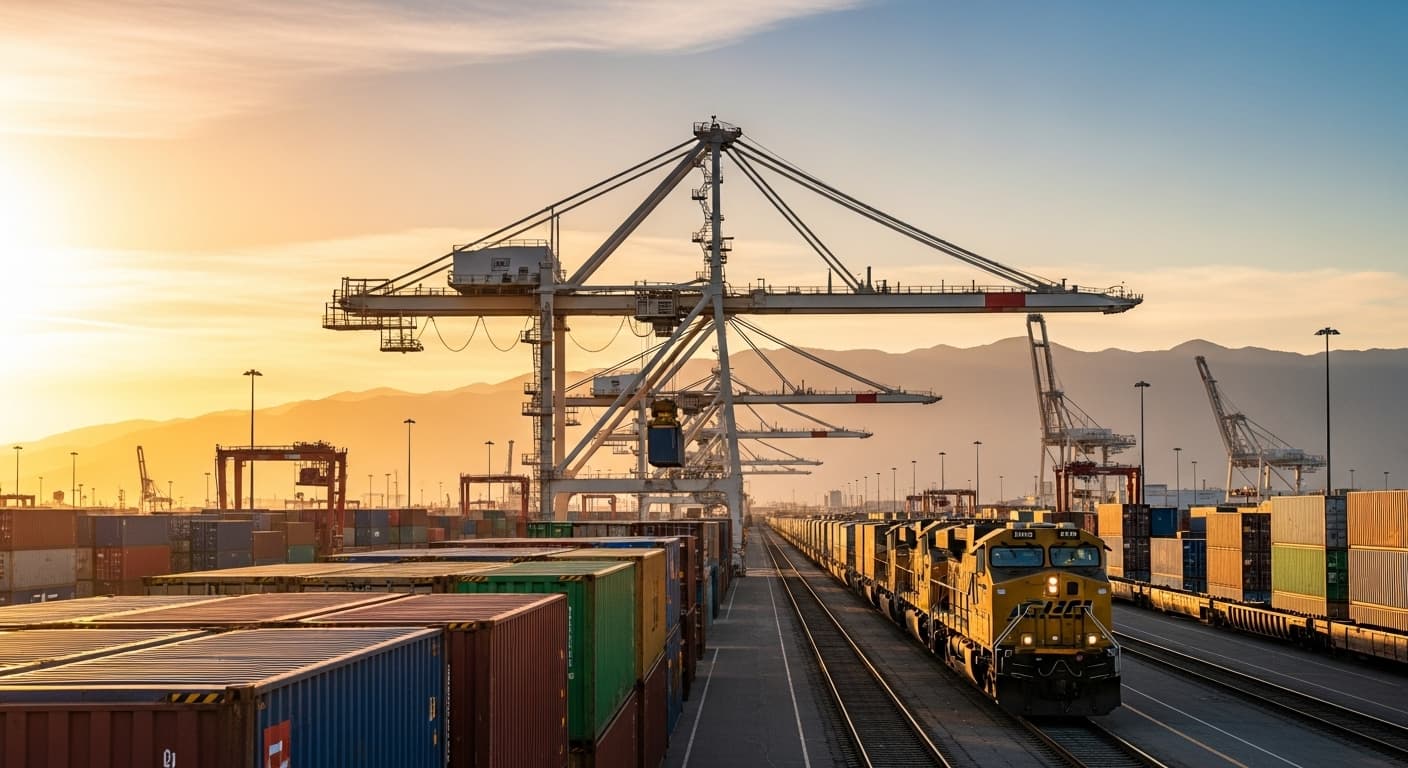
Executive Summary
Air freight demand from Asia has experienced significant growth in October 2025, driven primarily by robust e-commerce activity, seasonal factors, and evolving trade patterns. Spot rates on major Asia-origin lanes have increased substantially year-over-year, reflecting tight capacity conditions as growing demand meets constrained supply. Understanding the drivers behind this surge, capacity dynamics, and strategic implications enables shippers to navigate challenging market conditions effectively while managing costs and maintaining service levels.
Asia Air Freight Surge: E-Commerce Growth and Market Dynamics in October 2025
(亚洲航空货运激增:2025年10月电商增长与市场动态)
1 · Market Overview and Demand Drivers
Air freight markets originating from Asia demonstrate robust demand growth in October 2025, creating tight capacity conditions and upward rate pressure across major trade lanes.
Current Demand Levels
Year-Over-Year Growth: Air cargo demand from Asia shows substantial increases compared to October 2024, with specific lanes experiencing particularly strong growth:
Transpacific Lanes: Asia to US air freight spot rates reached $5.46 per kilogram in October 2025, representing approximately 49% increase year-over-year. This dramatic rate increase reflects both volume growth and capacity tightness creating favorable pricing environment for carriers.
Asia-Europe Corridor: The Asia-Europe trade lane also experiences significant demand increases, driven by e-commerce flows, supply chain reconfigurations, and seasonal factors affecting European markets.
Regional Variations: Different Asian origins show varying growth patterns based on local economic conditions, manufacturing activity, e-commerce development, and specific trade relationships with destination markets.
E-Commerce as Primary Driver
Online Shopping Growth: E-commerce represents primary driver of increased air freight demand from Asia:
Cross-Border E-Commerce: Asia-Pacific e-commerce sales project growth exceeding 15% in 2025, with substantial portion representing cross-border transactions requiring international shipping. Chinese platforms including Alibaba, rapid delivery expectations from consumers, and growing middle-class purchasing power throughout Asia all contribute to cross-border e-commerce expansion.
Speed Requirements: E-commerce business models emphasizing fast delivery create natural demand for air freight over slower ocean transportation. While ocean freight costs less, delivery time differences of weeks versus days drive air freight selection for many product categories.
Product Categories: Electronics and consumer technology, fashion and apparel, and small consumer goods particularly utilize air freight given their value-to-weight ratios, time sensitivity, and consumer expectations for rapid delivery.
Seasonal and Cyclical Factors
Holiday Season Preparation: October represents critical period for retailers preparing for holiday shopping season:
Inventory Positioning: Retailers ensuring adequate inventory for Thanksgiving, Black Friday, and December holiday shopping create concentrated demand surge in October air freight.
Just-in-Time Delivery: Rather than building large advance inventories, many retailers utilize air freight for responsive replenishment maintaining lean inventory while meeting demand spikes.
Post-Golden Week Dynamics: China’s Golden Week holiday in early October creates temporary production pause followed by catch-up period generating concentrated freight volumes as factories resume operations and work through backlogs.
2 · Capacity Constraints and Market Dynamics
The intersection of growing demand with limited capacity expansion creates tight market conditions and upward rate pressure.
Available Capacity Limitations
Belly Cargo Constraints: Significant portion of air cargo historically moves in belly hold of passenger aircraft. While passenger travel has recovered, belly cargo capacity hasn’t returned to pre-pandemic levels on all routes affecting overall capacity availability.
Dedicated Freighter Supply: Purpose-built cargo aircraft provide substantial capacity but fleet growth faces constraints including limited aircraft production capacity, high capital costs for new freighters, and retirement of older aircraft reducing net capacity additions.
Regional Variations: Some markets and lanes show tighter capacity than others based on aircraft deployment patterns, route profitability, and specific demand concentrations creating geographic imbalances.
Carrier Strategies
Capacity Management: Airlines managing capacity strategically to optimize revenue:
Yield Management: Sophisticated revenue management systems adjust pricing dynamically based on capacity utilization, demand forecasts, and competitive conditions maximizing revenue per available ton-kilometer.
Route Optimization: Carriers deploy aircraft on routes offering best revenue opportunities, potentially reducing service on lower-yield lanes during tight capacity periods.
Belly versus Freighter Balance: Airlines with both passenger and freighter operations balance capacity allocation between these segments based on relative profitability and strategic considerations.
Seasonal Capacity Adjustments
Peak Season Deployment: Carriers typically add capacity during peak seasons, but additions may not fully match demand growth creating sustained tightness throughout October and into November.
Charter Operations: Some shippers utilize charter aircraft during extreme peaks, though charter availability also becomes constrained during high-demand periods and costs can be substantially higher than scheduled service.
3 · Rate Environment and Pricing Dynamics
Tight capacity conditions translate directly into rate increases across major Asia-origin air freight lanes.
Spot Rate Increases
Transpacific Rates: Asia to US spot rates showing dramatic year-over-year increases with October 2025 rates at $5.46 per kilogram representing approximately 49% increase compared to October 2024. This substantial increase reflects strong demand fundamentals and limited capacity availability.
Comparison to Contract Rates: While spot rates surge during tight markets, contract rates negotiated earlier in year typically remain more stable. However, contract rate renewal negotiations reflect current market conditions with shippers facing substantial increases as contracts come up for renewal.
Rate Volatility: Air freight rates demonstrate greater volatility than ocean freight, with spot rates adjusting quickly to changing supply-demand conditions. This volatility creates budgeting challenges and requires active rate monitoring and management.
Cost Components
Fuel Surcharges: Jet fuel costs represent substantial portion of air freight expenses. Fuel surcharges adjust based on fuel price movements, though adjustment mechanisms and frequencies vary among carriers.
Security and Handling Fees: Various surcharges for security screening, terminal handling, and documentation add to base rates affecting total freight costs.
Dimensional Weight Pricing: Air freight pricing considers both actual and dimensional weight (calculated from package dimensions), with charges based on whichever is greater. This pricing approach significantly affects costs for bulky, lightweight shipments.
4 · Trade Pattern Evolution and Geographic Shifts
Evolving trade patterns and supply chain reconfigurations affect air freight demand patterns from different Asian origins.
China Plus One Impacts
Manufacturing Diversification: Many companies have diversified manufacturing beyond China to alternative Asian locations:
Vietnam Growth: Vietnam has experienced substantial manufacturing growth, particularly in electronics, textiles, and consumer goods. This expansion drives increased air freight volumes from Vietnamese origins as companies ship finished goods to global markets.
Other Emerging Origins: Bangladesh, Thailand, Indonesia, and other Southeast Asian countries also see growing manufacturing activity and corresponding air freight demand increases.
Infrastructure Constraints: While manufacturing grows in alternative locations, air cargo infrastructure may lag creating bottlenecks. Some emerging manufacturing hubs have limited freighter service, constrained airport capacity, or less developed logistics networks affecting air freight efficiency.
Tariff Impacts
Routing Adjustments: US tariffs on Chinese imports incentivize manufacturing and sourcing shifts:
Country of Origin Considerations: Products manufactured or substantially transformed in non-China locations may avoid or reduce tariff exposure, driving investment and production to alternative countries increasing air freight from these origins.
Transshipment Concerns: Customs authorities monitor for tariff avoidance through improper transshipment schemes. Legitimate manufacturing and value-added activity in alternative locations increases those countries’ export volumes genuinely.
5 · Strategic Considerations for Shippers
Organizations shipping via air freight from Asia should consider various strategies managing costs and ensuring capacity access during tight market conditions.
Capacity Securing Strategies
Contract Arrangements: Long-term capacity commitments with carriers provide several advantages:
Rate Stability: Contracts typically offer more stable pricing than spot markets, protecting against rate surges during peak periods though potentially paying premiums during soft markets.
Capacity Priority: Contracted volumes generally receive priority space allocation over spot market shipments during capacity-constrained periods.
Volume Commitments: Contracts typically require minimum volume commitments. Organizations must carefully assess ability to meet commitments and implications of shortfalls.
Multi-Carrier Strategies: Rather than single-carrier dependence, relationships with multiple carriers provide flexibility and backup options when primary carrier faces capacity constraints or service issues.
Modal Optimization
Air versus Ocean Trade-offs: Strategic modal selection balances cost, time, and service considerations:
Product Segmentation: Different products warrant different modal strategies based on value-to-weight ratios, time sensitivity, inventory carrying costs, and demand predictability. High-value, time-sensitive products justify air freight while commodity items typically move via ocean.
Hybrid Approaches: Some organizations use hybrid strategies shipping portions of orders via air for rapid replenishment while maintaining base inventory through ocean shipments balancing service and cost.
Air-Ocean Combinations: Expedited ocean services, air-to-ocean transshipment, and other hybrid approaches provide intermediate options between pure air and pure ocean freight.
Demand Planning and Forecasting
Proactive Planning: Better demand forecasting enables more effective capacity planning:
Seasonal Pattern Recognition: Historical patterns inform expectations for peak periods enabling advance capacity securing and budget planning.
Promotional Coordination: Aligning promotional activities, product launches, and other demand drivers with logistics capabilities ensures adequate capacity availability during high-demand periods.
Buffer Strategies: Strategic safety stock positioning, advance inventory building for peak periods, and flexible fulfillment networks provide buffers against supply chain disruptions and capacity constraints.
6 · Technology and Visibility Solutions
Technology platforms provide capabilities for managing air freight more effectively in dynamic market conditions.
Rate Shopping and Booking
Digital Platforms: Online freight marketplaces and booking platforms enable rate comparison across multiple carriers, real-time capacity availability visibility, and streamlined booking processes.
Automated Systems: Integration between shippers’ systems and carrier platforms enables automated rate shopping, booking, and documentation reducing manual effort and processing time.
Shipment Tracking and Visibility
Real-Time Monitoring: Modern tracking capabilities provide visibility throughout air freight journey:
Milestone Tracking: Automatic updates at key milestones including pickup, airport arrival, departure, destination arrival, and delivery enable proactive exception management.
Predictive Alerts: Advanced systems predict potential delays based on current conditions enabling proactive customer communication and contingency planning.
Multi-Carrier Visibility: Platforms aggregating tracking data across multiple carriers provide unified visibility regardless of which carrier handles specific shipments.
Analytics and Optimization
Performance Analysis: Historical data analysis identifies patterns and improvement opportunities:
Carrier Performance: Systematic measurement of on-time performance, damage rates, and other metrics informs carrier selection and relationship management.
Lane Analysis: Understanding which lanes and routings perform best supports network optimization and strategic routing decisions.
Cost Modeling: Comprehensive cost modeling considering all rate components, surcharges, and related expenses enables accurate total landed cost calculations supporting modal and carrier selection.
7 · Regional Variations and Market Nuances
Air freight markets from different Asian origins demonstrate varying characteristics affecting strategy and operations.
China Market Characteristics
Infrastructure Maturity: China offers well-developed air cargo infrastructure with major cargo hubs in Shanghai, Beijing, Guangzhou, and Shenzhen providing extensive freighter service and efficient processing.
E-Commerce Integration: Sophisticated e-commerce logistics ecosystems integrate air freight seamlessly with domestic distribution and cross-border platforms.
Regulatory Environment: Understanding Chinese export regulations, documentation requirements, and customs procedures is essential for efficient air freight operations.
Southeast Asian Markets
Capacity Development: Vietnam, Thailand, and other Southeast Asian countries continue developing air cargo capabilities:
Infrastructure Investment: Airport expansions, cargo terminal development, and enhanced handling capabilities support growing freight volumes though infrastructure may lag demand in some locations.
Service Availability: Freighter service availability varies with major hubs offering better connectivity while secondary locations may have limited direct service requiring transshipment.
South Asian Considerations
India and Bangladesh: Growing manufacturing in India and Bangladesh drives air freight growth:
Apparel and Textiles: Significant air freight of fashion and textile products from these origins serves fast-fashion business models requiring rapid replenishment.
Infrastructure Challenges: Some locations face infrastructure constraints affecting efficiency and costs requiring careful operational planning.
8 · Environmental and Sustainability Considerations
Air freight’s environmental impact creates increasing focus on sustainability strategies and carbon footprint management.
Carbon Emissions
Environmental Impact: Air freight produces substantially higher carbon emissions per ton-kilometer than ocean freight creating environmental concerns and potential regulatory implications.
Emissions Reporting: Growing requirements for carbon footprint measurement and reporting affect companies utilizing air freight as stakeholders demand transparency about environmental impacts.
Sustainability Strategies
Emission Reduction: Various approaches can reduce air freight’s environmental impact:
Modal Shift: Where time requirements permit, shifting appropriate shipments from air to ocean substantially reduces carbon footprint though requiring longer lead times.
Aircraft Efficiency: Newer aircraft offer better fuel efficiency reducing emissions per ton-kilometer. Carrier aircraft fleet composition affects environmental performance.
Sustainable Aviation Fuel: Emerging sustainable aviation fuels offer potential for substantial emission reductions though current availability and costs constrain widespread adoption.
Carbon Offsetting: Some shippers purchase carbon offsets to compensate for air freight emissions though offset quality and effectiveness vary requiring careful program selection.
9 · Future Outlook and Market Evolution
Understanding likely future developments helps inform longer-term strategic planning and positioning.
Near-Term Projections
Q4 2025 Expectations: Air freight demand likely remains strong through remainder of 2025 driven by continued holiday shopping activity, year-end inventory positioning, and sustained e-commerce growth maintaining pressure on capacity and rates.
Rate Trajectory: Whether current rate levels sustain depends on demand persistence, capacity additions, and seasonal patterns. Historical patterns suggest some moderation following peak holiday period though structural demand growth may limit declines.
Longer-Term Trends
E-Commerce Structural Growth: Continued e-commerce penetration growth, especially in emerging markets, cross-border shopping expansion, and fast-delivery business models create structural air freight demand growth beyond cyclical fluctuations.
Supply Chain Reconfiguration: Ongoing manufacturing diversification, nearshoring and friendshoring trends, and supply chain resilience focus all affect future air freight demand patterns and origin-destination flows.
Technology Impact: Advanced forecasting, automated booking, and optimization technologies improve air freight efficiency and utilization though may not fundamentally change capacity-demand dynamics.
Capacity Development
Fleet Additions: Aircraft manufacturer production rates, freighter conversion economics, and carrier investment decisions determine future capacity growth. Current production constraints suggest capacity additions may lag demand growth maintaining relatively tight markets.
10 · Conclusion: Navigating Tight Air Freight Markets
Current Market Realities
Demand Strength: Asia air freight demand in October 2025 demonstrates robust growth driven by e-commerce expansion, seasonal factors, and evolving trade patterns. This strength creates tight capacity conditions and upward rate pressure affecting shippers across industries.
Capacity Constraints: Limited capacity growth relative to demand expansion creates sustained tightness in air freight markets. While carriers add capacity where economically justified, structural constraints limit how quickly supply can respond to growing demand.
Rate Environment: Substantial year-over-year rate increases reflect underlying supply-demand imbalances. While rates may moderate from peak levels, structural factors suggest air freight from Asia likely remains relatively expensive compared to historical averages.
Strategic Success Factors
Proactive Planning: Organizations successfully navigating tight markets demonstrate proactive demand planning, advance capacity securing, flexible strategies adapting to changing conditions, and strong carrier relationships providing priority access.
Balanced Approaches: Effective strategies balance multiple considerations including cost management versus service reliability, contract commitments versus spot market flexibility, single versus multiple carrier relationships, and air versus alternative modal options.
Continuous Adaptation: Air freight markets evolve continuously based on economic conditions, competitive dynamics, regulatory changes, and technological developments. Successful organizations maintain awareness of market trends and adapt strategies accordingly.
Moving Forward
Organizations utilizing air freight from Asia should monitor market developments closely, reassess strategies regularly based on evolving conditions, maintain flexibility in operations and carrier relationships, and invest in technology and capabilities supporting effective air freight management.
The October 2025 surge in Asia air freight demand reflects broader trends likely persisting beyond immediate peak season. Understanding these dynamics and implementing appropriate strategies enables organizations to manage costs effectively while maintaining service levels and operational efficiency in challenging market conditions.
This analysis reflects current understanding of Asia air freight markets based on available data and industry reporting. Market conditions evolve continuously and specific circumstances vary by shipper, lane, and commodity. Organizations managing air freight from Asia should consult with freight forwarders, air cargo specialists, and logistics professionals who can provide guidance specific to their particular requirements and circumstances.



